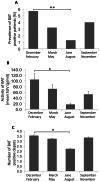Prevalence, mass, and glucose-uptake activity of ¹⁸F-FDG-detected brown adipose tissue in humans living in a temperate zone of Italy
- PMID: 23667608
- PMCID: PMC3648481
- DOI: 10.1371/journal.pone.0063391
Prevalence, mass, and glucose-uptake activity of ¹⁸F-FDG-detected brown adipose tissue in humans living in a temperate zone of Italy
Abstract
Background: The ¹⁸F-fluorodeoxyglucose (¹⁸F-FDG)-detected brown adipose tissue (BAT), is enhanced by cold stimulus and modulated by other factors that still have to be disentangled. We investigated the prevalence, mass, and glucose-uptake activity of ¹⁸F-FDG-detected BAT in a population of adults living in the temperate climatic zone of the Rome area.
Methods and findings: We retrospectively analyzed 6454 patients who underwent ¹⁸F-FDG positron emission tomography/computed tomography (PET/CT) examinations. We found ¹⁸F-FDG BAT in 217 of the 6454 patients (3.36%). Some of them underwent more than one scan and the positive scans were 278 among 8004 (3.47%). The prevalence of patients with at least one positive scan was lower in men (1.77%; 56 of 3161) compared with women (4.88%; 161 of 3293). The BAT positive patients were most frequently younger, thinner and with lower plasma glucose levels compared with BAT negative patients. The amount of BAT in the defined region of interest, the activity of BAT and the number of positive sites of active BAT were similar in both sexes. The prevalence of patients with ¹⁸F-FDG positive PET/CT was highest in December-February, lower in March-May and September-November, and lowest in June-August and was positively correlated with night length and negatively correlated with ambient temperature. Changes in day length and variations of temperature, associated with the prevalence of positive BAT patients. Among the patients who had multiple scans, outdoor temperature was significantly lower and day length was shorter on the occasion when BAT was detected.
Conclusions: This study identifies day length, outdoor temperature, age, sex, BMI, and plasma glucose levels as major determinants of the prevalence, mass, and activity of ¹⁸F-FDG-detected BAT.
Conflict of interest statement
Figures





References
-
- Tam CS, Lecoultre V, Ravussin E (2012) Brown adipose tissue: mechanisms and potential therapeutic targets. Circulation 125: 2782–2791. - PubMed
-
- Cannon B, Nedergaard J (2004) Brown adipose tissue: function and physiological significance. Physiol Rev 84: 277–359. - PubMed
-
- Nedergaard J, Bengtsson T, Cannon B (2007) Unexpected evidence for active brown adipose tissue in adult humans. Am J Physiol Endocrinol Metab 293: E444–E452. - PubMed
-
- van Marken Lichtenbelt WD, Vanhommerig JW, Smulders NM, Drossaerts JM, Kemerink GJ, et al. (2009) Cold-activated brown adipose tissue in healthy men. N Engl J Med 360: 1500–1508. - PubMed
Publication types
MeSH terms
Substances
LinkOut - more resources
Full Text Sources
Other Literature Sources

